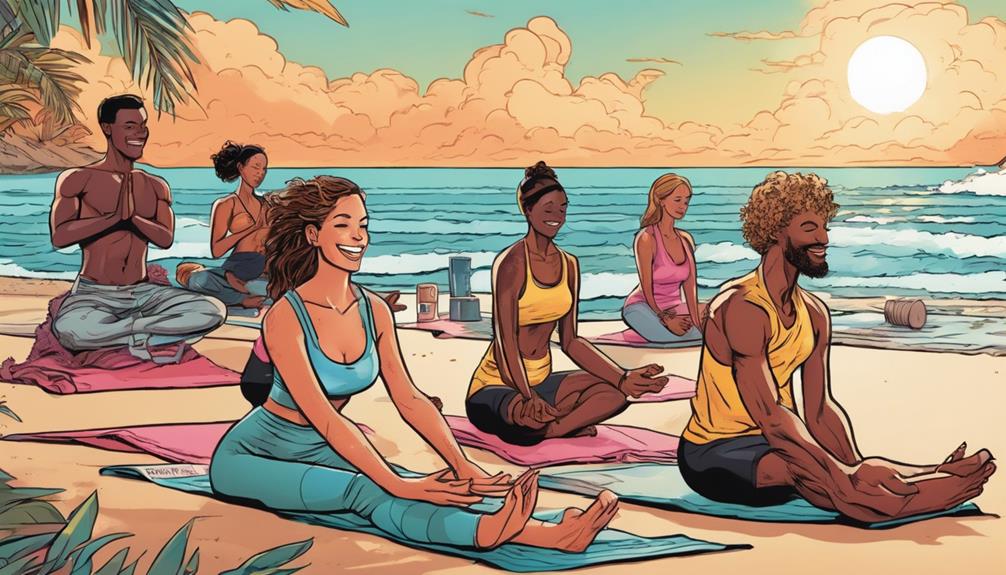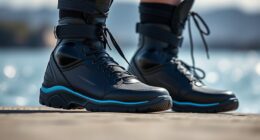To get a beach-ready body, focus on core workouts like planks, bicycle crunches, leg raises, and Russian twists to target your abs and obliques. Incorporate mountain climbers for cardio and deep core stability exercises such as dead bugs and side planks. Combine controlled movements with consistency, avoiding common mistakes like swinging or rushing reps. Keep progressing with resistance tools to maximize results. Stick with it, and you’ll discover more ways to sculpt your abs and boost your confidence.
Key Takeaways
- Incorporate plank variations, side planks, and leg lifts to build core strength and stability.
- Use bicycle crunches and Russian twists to sculpt obliques and enhance muscle endurance.
- Focus on deep core activation exercises like dead bugs and flutter kicks for waistline definition.
- Include leg raises and their progressions to target lower abs effectively.
- Combine cardio moves like mountain climbers with dynamic movements for full-body engagement and fat burning.
Plank Variations to Strengthen Your Core
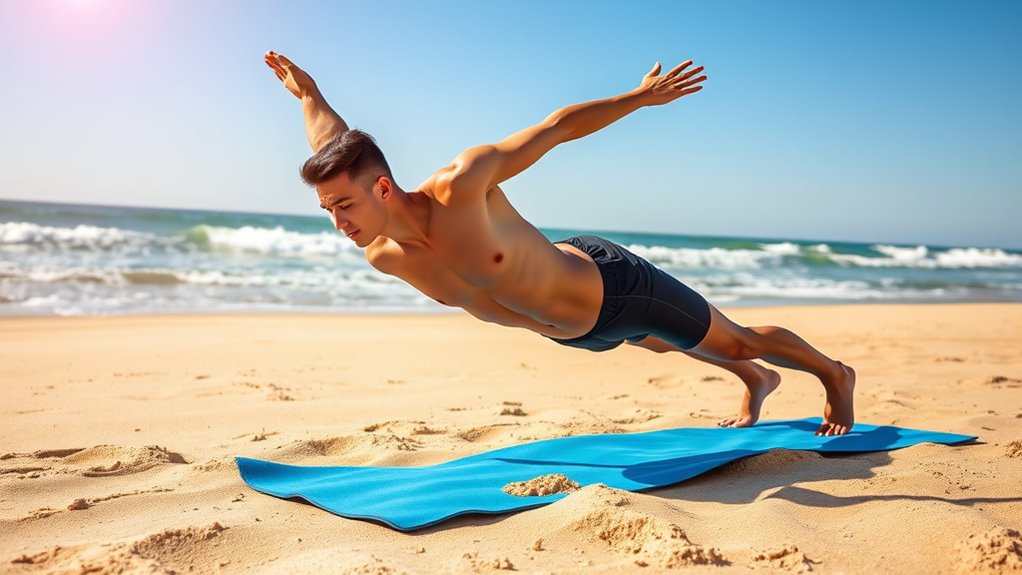
To effectively strengthen your core, incorporating a variety of plank variations can make a significant difference. By switching up your planks, you target different muscles and prevent workout boredom. Start with the standard forearm plank, keeping your elbows beneath your shoulders and engaging your abs. From there, try side planks to activate your obliques, supporting your waistline. You can also incorporate plank with leg lifts, raising one leg at a time to challenge your lower back and glutes. Another effective variation is the plank with shoulder taps, which tests your stability and engages your upper body. Maintain proper form throughout each variation, focusing on a straight line from head to heels. Regularly integrating different plank styles can improve your overall core strength, and using advanced variations can further enhance your results. Incorporating proper technique ensures safety and maximizes the effectiveness of each move. Consistent practice of these variations not only boosts muscle activation, but also improves your endurance, leading to increased stamina and performance. This comprehensive approach supports your goal of building a stronger, more defined core for that beach-ready body.
Bicycle Crunches for Oblique Toning

Bicycle crunches target your oblique muscles, helping you achieve a more defined waistline. This exercise also improves core stability, making everyday movements easier and safer. Plus, it increases calorie burn, supporting your overall fitness goals. Incorporating core strength exercises like bicycle crunches can enhance your posture and reduce the risk of injury during other physical activities.
Engages Oblique Muscles
Engaging your oblique muscles is essential for sculpting a toned waistline, and bicycle crunches are one of the most effective exercises for this purpose. When you perform this move, you rotate your torso as you bring opposite elbow to knee, activating your obliques with each twist. This movement targets the side abdominal muscles, helping to define your waist. Keep your movements controlled and focus on squeezing your obliques as you crunch and twist. Avoid rushing through the exercise, as proper form maximizes muscle engagement and reduces injury risk. Additionally, proper form ensures that you target the correct muscles and prevent strain during the exercise. It is also helpful to incorporate safety precautions like avoiding excessive heat when using styling tools to prevent damage, especially when curling synthetic wigs. Incorporating core stability exercises further enhances overall muscle engagement and supports your toned appearance. According to relationships insights, consistent effort and mindful practice contribute to better results and sustained motivation. By consistently incorporating bicycle crunches into your routine, you’ll strengthen and tone your obliques, creating a more sculpted, beach-ready physique. This exercise not only improves muscle endurance but also enhances your overall core appearance. Furthermore, integrating moves like bicycle crunches can complement AI-powered fitness tools that analyze your form and optimize your workout efficiency.
Enhances Core Stability
Incorporating bicycle crunches into your routine not only tones your obliques but also considerably boosts your core stability. As you perform the movement, your deep abdominal muscles engage to maintain balance and control, strengthening the foundation that supports your entire body. This improved stability helps stabilize your spine, reducing the risk of injury and enhancing posture. The dynamic nature of bicycle crunches challenges your core to work in multiple directions, increasing overall strength and endurance. Additionally, engaging in core exercises like bicycle crunches can enhance cognitive function, supporting mental clarity and focus. Incorporating core stabilization techniques into your training routine can offer personalized feedback and optimize your workout effectiveness. By consistently adding bicycle crunches to your workout, you’ll develop a resilient, stable core that enables you to move confidently and with greater control on the beach or during any physical activity. Regularly practicing core strengthening exercises like bicycle crunches can also contribute to improved posture and alignment, which benefits overall health and reduces discomfort.
Boosts Calorie Burn
Because bicycle crunches involve dynamic, full-body movement, they considerably increase your calorie burn. As you switch sides and rotate your torso, you engage multiple muscle groups, elevating your heart rate and burning more calories. This exercise not only targets your obliques but also activates your core, hips, and legs, making it an efficient workout for fat loss. To illustrate, here’s how different muscles contribute:
| Muscle Group | Action During Bicycle Crunches | Calories Burned (Estimate) |
|---|---|---|
| Obliques | Twisting torso movement | 8-12 calories/min |
| Rectus Abdominis | Stabilizing core | 5-8 calories/min |
| Hip Flexors | Lifting legs | 6-10 calories/min |
Incorporate bicycle crunches regularly for effective calorie burning and toned obliques.
Leg Raises to Target the Lower Abs

To maximize your results, focus on maintaining proper form and technique during leg raises. Try different variations to challenge your lower abs as you progress, but be mindful of common mistakes like swinging or using momentum. Staying aware of these points will help you build strength effectively and avoid injury.
Proper Form & Technique
Proper form is essential when performing leg raises to effectively target your lower abs and prevent injury. Lie flat on your back with your legs extended and arms at your sides or underneath your hips for support. Keep your legs straight and slowly lift them toward the ceiling, engaging your lower abs. Avoid using momentum; instead, control the movement and avoid swinging your legs. As you lift, ensure your lower back stays pressed into the floor to prevent strain. Pause briefly at the top of the movement, then slowly lower your legs without letting them touch the ground. Maintain steady breathing throughout, exhaling as you lift and inhaling as you lower. Focus on engaging your core with each repetition to maximize effectiveness and minimize strain.
Variations for Progression
Once you’ve mastered basic leg raises with proper form, adding variations can help challenge your lower abs further and promote continued progress. One effective variation is the hanging leg raise, which increases resistance and engages your core more intensely. You can also try scissor kicks, where you alternate crossing your legs in a controlled manner to target different lower abs muscles. Another option is the slow, controlled leg raise with a pause at the top, emphasizing muscle engagement. To increase difficulty, incorporate ankle weights or resistance bands. These variations prevent plateaus, deepen the burn, and strengthen your lower abs more effectively. Additionally, understanding the bedroom of major entertainment industries highlights the importance of strategic investment in personal fitness goals. Proper technique and consistency remain essential as you introduce these progressions to elevate your core workout.
Common Mistakes to Avoid
Many people make common mistakes when performing leg raises to target the lower abs, which can reduce effectiveness and increase the risk of injury. One mistake is using momentum instead of controlled movement, causing you to rely on swinging your legs rather than engaging your abs. Another is lifting your legs too high or arching your back, which strains your lower back and diminishes core engagement. Failing to keep your core tight or allowing your hips to tilt can also lessen the workout’s impact. Additionally, rushing through reps or not focusing on proper form limits results. To get the most from leg raises, perform them slowly, maintain a slight pelvic tilt, and keep your lower back pressed into the floor. Proper form guarantees safety and maximizes lower abs activation. Incorporating somatic awareness techniques can also help you stay mindful of your body position and improve your exercise form. Paying attention to core engagement throughout the movement ensures you activate the targeted muscles effectively and safely. Developing body awareness can further enhance your ability to perform exercises with proper technique and prevent injuries. According to studies, consistent practice and proper form are key to seeing results in your lower abdominal muscles. Using appropriate equipment such as an exercise mat can also provide better stability and comfort during your workout.
Russian Twists for Rotational Stability
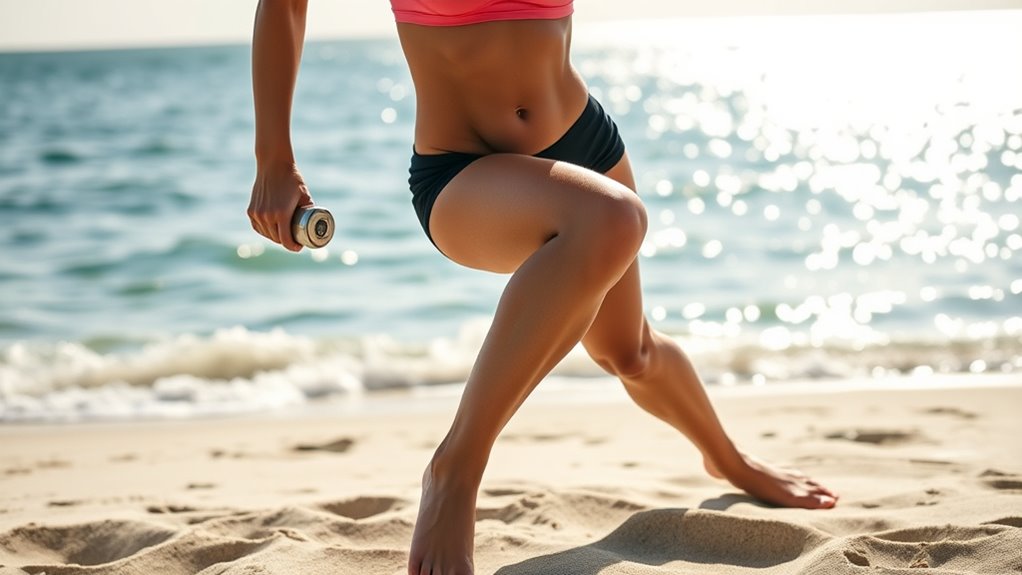
Russian twists are an effective exercise for building rotational stability in your core. To do them, sit on the floor with your knees bent and feet flat, then lean back slightly while keeping your back straight. Hold a weight or just clasp your hands together, and twist your torso from side to side, engaging your obliques and abs. Focus on controlled movements rather than rushing through reps. This exercise strengthens your rotational muscles, improving overall core stability, which helps with daily activities and athletic performance. Make sure to keep your core tight throughout and avoid over-rotating or using momentum. Incorporate Russian twists into your routine a few times a week to enhance your core’s rotational strength and achieve that beach-ready physique.
Mountain Climbers for Cardio and Core Engagement

Mountain climbers are a dynamic exercise that effectively combine cardio and core engagement to boost your fitness. As you get into a high plank position, keep your hands under your shoulders and your body straight. Quickly bring one knee towards your chest, then switch legs in a rapid, controlled motion. This movement increases your heart rate while targeting your abdominal muscles, shoulders, and hips. By maintaining steady, swift repetitions, you improve cardiovascular endurance and core stability simultaneously. Mountain climbers also boost coordination and agility, making them a versatile addition to your workout. Keep your core tight throughout, avoiding sagging hips or raised buttocks. Incorporate this exercise into your routine for a full-body burn that sculpts your abs and elevates your cardio.
Dead Bug for Deep Core Activation
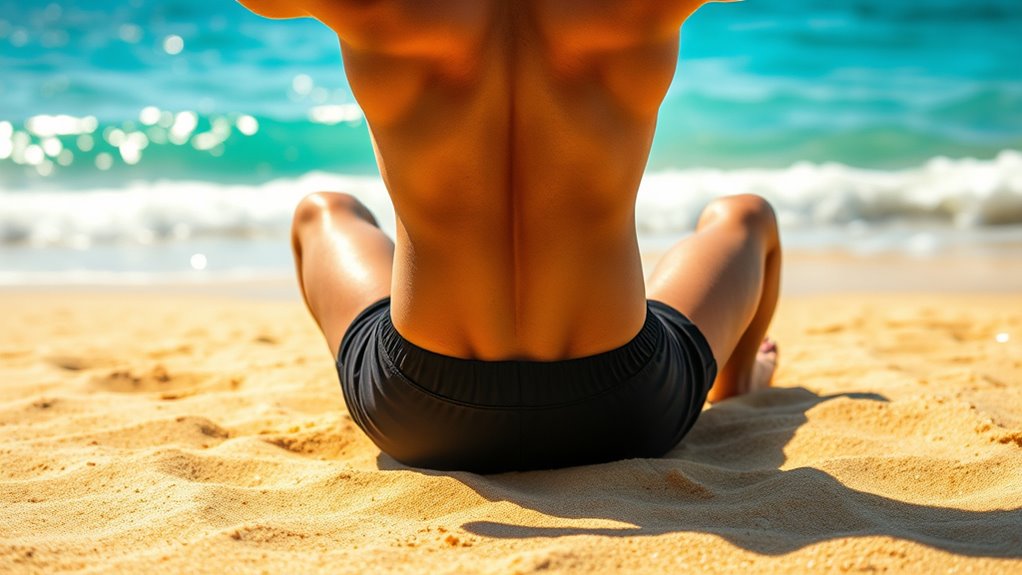
Building on the cardio and core engagement from mountain climbers, incorporating the Dead Bug targets your deep abdominal muscles for improved stability. This exercise enhances spinal support and prevents injury by strengthening your deep core. Lie on your back with arms extended toward the ceiling and knees bent at 90 degrees. Slowly lower one arm and the opposite leg toward the floor, keeping your back flat. Return to the starting position and switch sides. The key is controlled movement, focusing on core activation rather than speed. To keep your workout organized, follow this rhythm:
| Step | Action | Focus Area |
|---|---|---|
| 1 | Lie flat, arms up | Set your position |
| 2 | Lower opposite arm/leg | Deep core activation |
| 3 | Return to start | Stability reinforcement |
| 4 | Repeat on the other side | Balance and control |
Side Planks to Sculpt Your Flanks
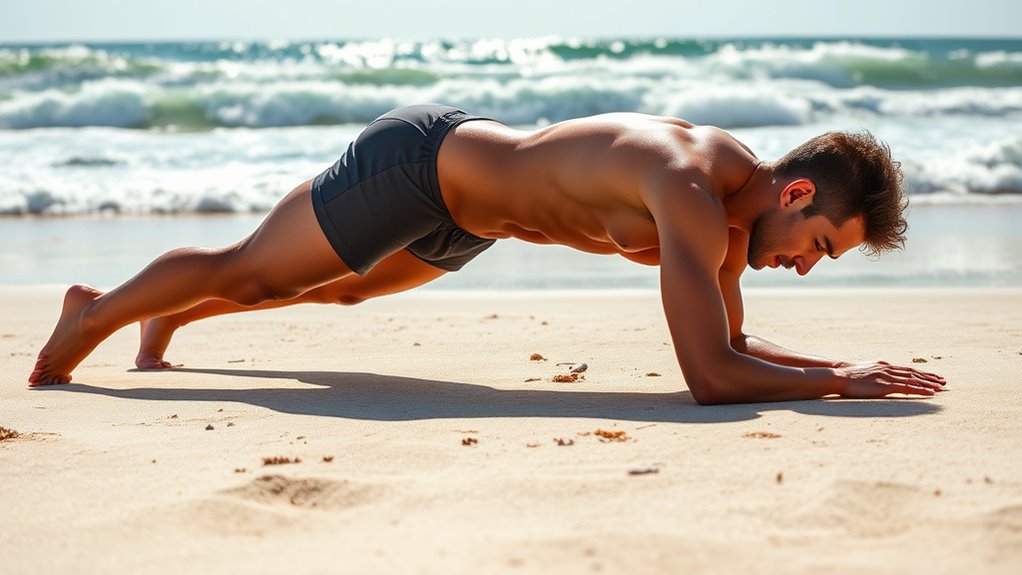
To effectively sculpt your flanks and enhance core stability, side planks are a powerful addition to your workout. They target the obliques, helping to tighten and define your waistline. Start by lying on your side with your legs extended and your elbow directly beneath your shoulder. Engage your core and lift your hips off the ground, creating a straight line from head to feet. Hold this position, keeping your hips elevated without sagging. Switch sides to ensure balanced development. For added challenge, you can raise your top leg or arm. Side planks not only sculpt your flanks but also improve overall stability, making everyday movements easier. Incorporate them into your routine 2-3 times a week for best results.
Flutter Kicks for Lower Abdominal Endurance

If you want to strengthen your lower abs and boost endurance, flutter kicks are a highly effective exercise to add to your core routine. To perform them, lie on your back with your hands under your hips for support. Keep your legs straight and lift them about six inches off the ground. Quickly alternate kicking your legs up and down in small, controlled movements. Focus on engaging your lower abs throughout the exercise. Maintain a steady pace and avoid arching your back to prevent strain. Aim for 30 to 60 seconds per set, gradually increasing as your endurance improves. Flutter kicks target your lower abdominal muscles, helping you develop the strength and stamina needed for a toned, beach-ready core.
Frequently Asked Questions
How Often Should I Perform Core Workouts for Optimal Results?
You should aim to perform core workouts about three to four times a week for ideal results. This frequency allows your muscles to recover while still providing enough stimulation to build strength and endurance. Incorporate a variety of exercises targeting different core muscles, and don’t forget to include rest days. Consistency is key, so stick to your schedule and gradually increase intensity for the best outcomes.
Can Core Exercises Help Reduce Belly Fat?
You might notice that while core exercises tone your abdominal muscles, they don’t directly burn belly fat. Fat loss happens through overall calorie burning, combining cardio and strength training. When you incorporate core workouts into your routine, they strengthen muscles and improve posture, which can make your belly look flatter. So, yes, they help define your abs, but for actual fat reduction, focus on a all-encompassing fitness plan.
Are Core Workouts Suitable for Beginners?
You’re wondering if core workouts are suitable for beginners. The good news is, yes, they are! Many core exercises are simple and low-impact, making them perfect for those just starting out. You can modify movements to match your fitness level, gradually increasing intensity. Focus on proper form, and don’t rush progress. Consistency is key, and soon you’ll build strength and stability without feeling overwhelmed.
How Long Does It Take to See Visible Core Improvements?
You wonder how long it takes to see visible core improvements. It varies based on your starting point, workout consistency, and diet. Typically, if you exercise regularly and maintain a healthy diet, you might notice changes in 4 to 6 weeks. Stay committed, focus on proper form, and progressively challenge yourself. With patience and persistence, you’ll start seeing those core muscles become more defined over time.
Should I Combine Core Exercises With Other Workouts for Best Results?
Combining core exercises with other workouts definitely boosts your results. You’ll build strength more efficiently and improve overall fitness faster. Incorporate cardio, strength training, and flexibility routines alongside core work to maximize benefits. This holistic approach helps burn fat, tone muscles, and enhance stability. So, don’t just focus on core exercises alone—mix them with other workouts for a balanced, effective fitness plan that gets you closer to your beach-ready body.
Conclusion
By mixing these core workouts into your routine, you’ll build a strong, toned midsection that’s beach-ready in no time. Stay consistent and push yourself—progress doesn’t happen overnight, but with dedication, you’ll see results. Remember, Rome wasn’t built in a day, so don’t get discouraged if progress feels slow. Keep at it, stay motivated, and soon enough, you’ll be rocking that confidence with a sculpted core.





